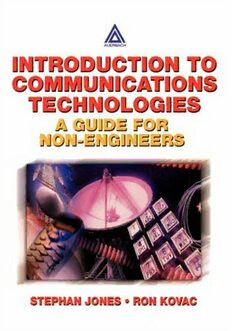Download Introduction to Communications Technologies: A Guide for Non-Engineers PDF Free - Full Version
Download Introduction to Communications Technologies: A Guide for Non-Engineers by Stephan Jones, Ron Kovac in PDF format completely FREE. No registration required, no payment needed. Get instant access to this valuable resource on PDFdrive.to!
About Introduction to Communications Technologies: A Guide for Non-Engineers
Most textbooks on this subject focus heavily on the mathematical perspective of communication. Today's managers do not need to know how to figure out the quantization process of an analog sample, they simply need to understand how the theory works-in plain English. Introduction to Communications Technologies: A Guide for Non-Engineers is a quick-read tutorial on telecommunications and network technologies for graduate and undergraduate students in management information systems and telecommunications management courses.While dealing with the engineering aspects of communication, the book provides a basic understanding of how things work, not how to design systems. Topics include systems, electricity, signaling, telephony, switching, wireless, CTI, and video. It also explains the important relationship between the two major languages spoken in the industry, voice and data, something not done in other texts. The material covered is the same as that presented in a graduate-level core technical course at one of the most respected Information and Communication Services programs in the country.Students will not need a technical background in order to gain the valuable knowledge that lies within these pages. Designed to provide students with a foundation of knowledge that will serve them well into their careers, Introduction to Communications Technologies: A Guide for Non-Engineers provides students with the tools necessary to become effective leaders of technology professionals.
Detailed Information
| Author: | Stephan Jones, Ron Kovac |
|---|---|
| Publication Year: | 2002 |
| ISBN: | 9780849312663 |
| Pages: | 278 |
| Language: | English |
| File Size: | 2.849 |
| Format: | |
| Price: | FREE |
Safe & Secure Download - No registration required
Why Choose PDFdrive for Your Free Introduction to Communications Technologies: A Guide for Non-Engineers Download?
- 100% Free: No hidden fees or subscriptions required for one book every day.
- No Registration: Immediate access is available without creating accounts for one book every day.
- Safe and Secure: Clean downloads without malware or viruses
- Multiple Formats: PDF, MOBI, Mpub,... optimized for all devices
- Educational Resource: Supporting knowledge sharing and learning
Frequently Asked Questions
Is it really free to download Introduction to Communications Technologies: A Guide for Non-Engineers PDF?
Yes, on https://PDFdrive.to you can download Introduction to Communications Technologies: A Guide for Non-Engineers by Stephan Jones, Ron Kovac completely free. We don't require any payment, subscription, or registration to access this PDF file. For 3 books every day.
How can I read Introduction to Communications Technologies: A Guide for Non-Engineers on my mobile device?
After downloading Introduction to Communications Technologies: A Guide for Non-Engineers PDF, you can open it with any PDF reader app on your phone or tablet. We recommend using Adobe Acrobat Reader, Apple Books, or Google Play Books for the best reading experience.
Is this the full version of Introduction to Communications Technologies: A Guide for Non-Engineers?
Yes, this is the complete PDF version of Introduction to Communications Technologies: A Guide for Non-Engineers by Stephan Jones, Ron Kovac. You will be able to read the entire content as in the printed version without missing any pages.
Is it legal to download Introduction to Communications Technologies: A Guide for Non-Engineers PDF for free?
https://PDFdrive.to provides links to free educational resources available online. We do not store any files on our servers. Please be aware of copyright laws in your country before downloading.
The materials shared are intended for research, educational, and personal use in accordance with fair use principles.

